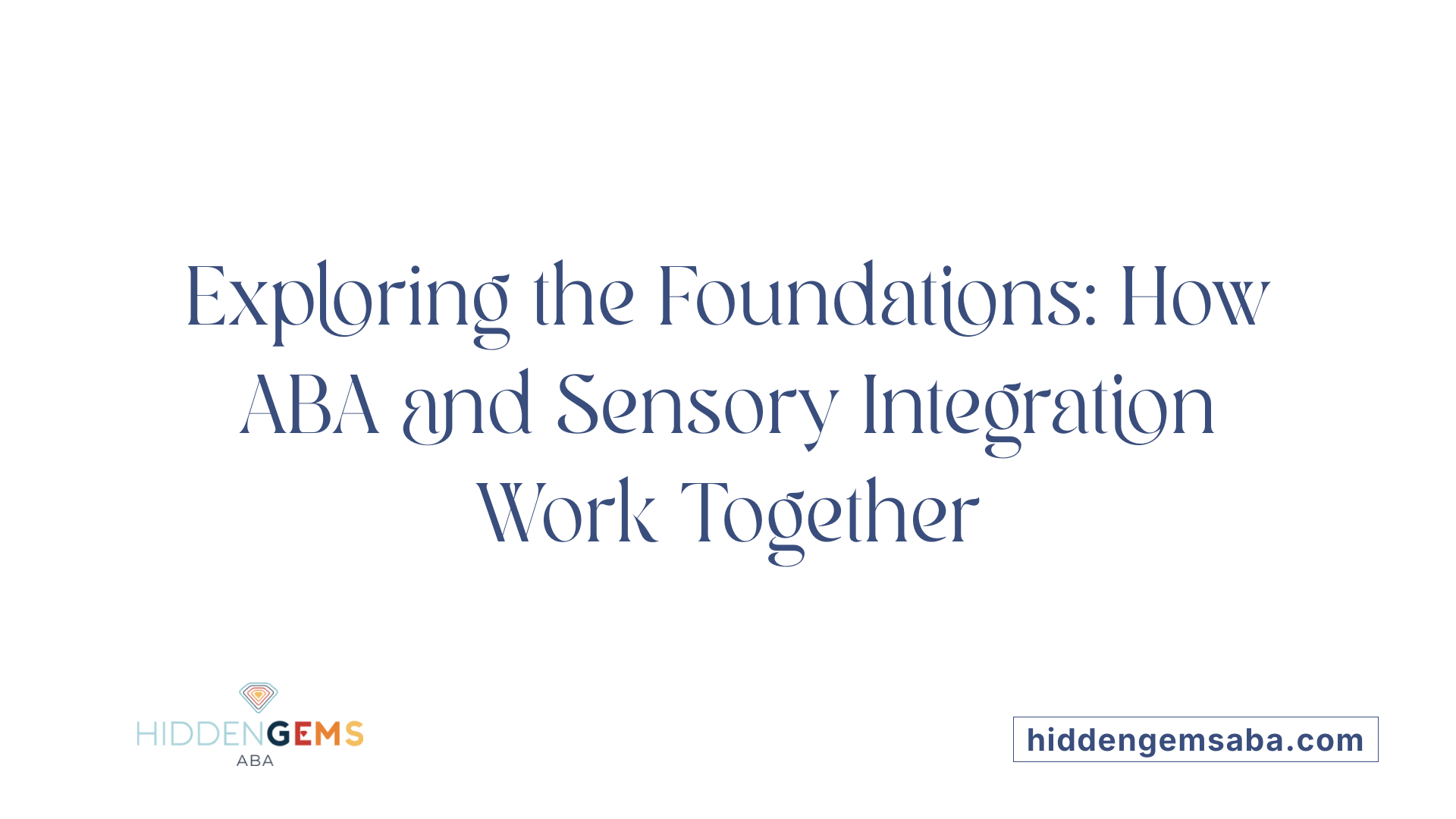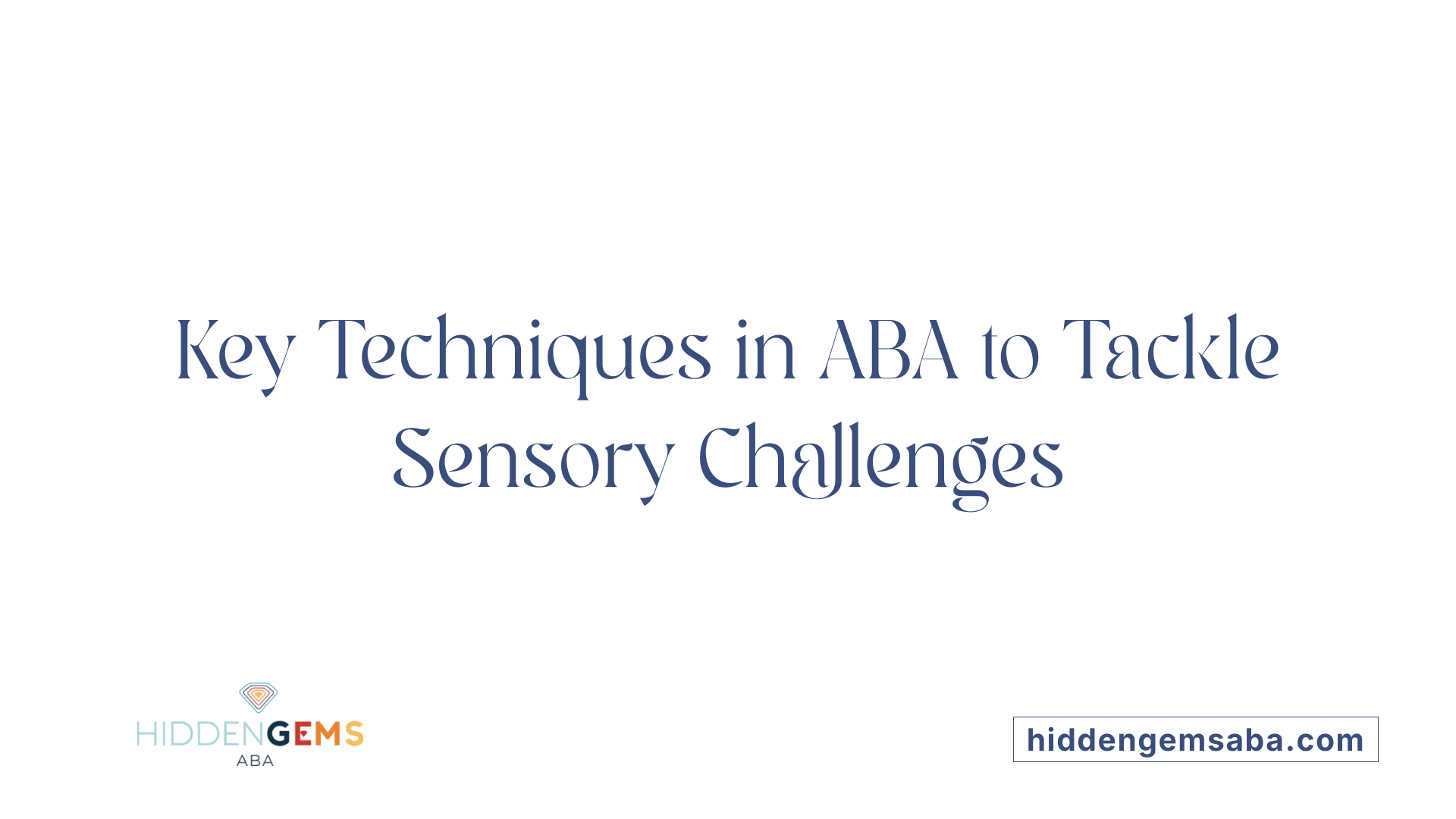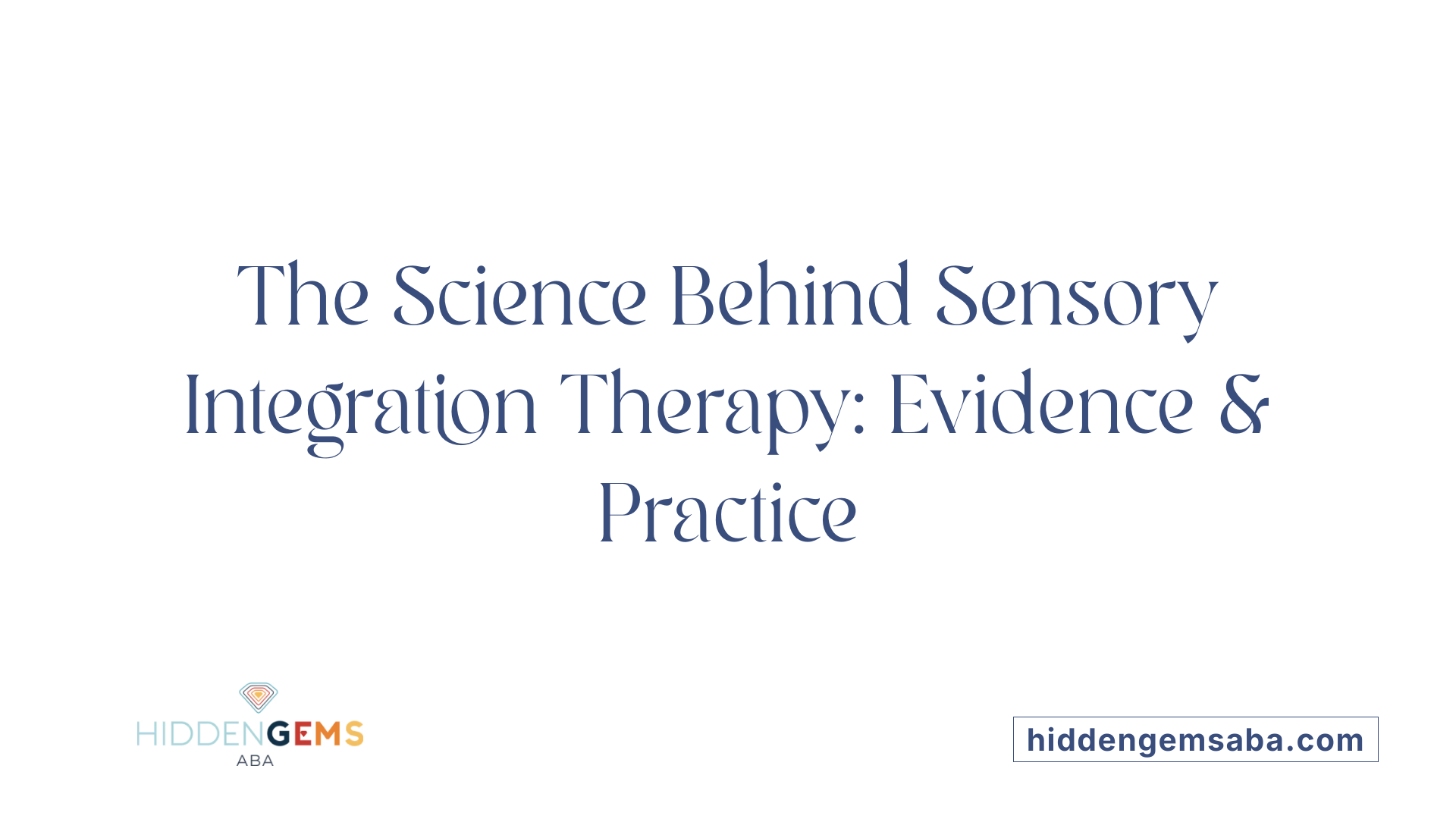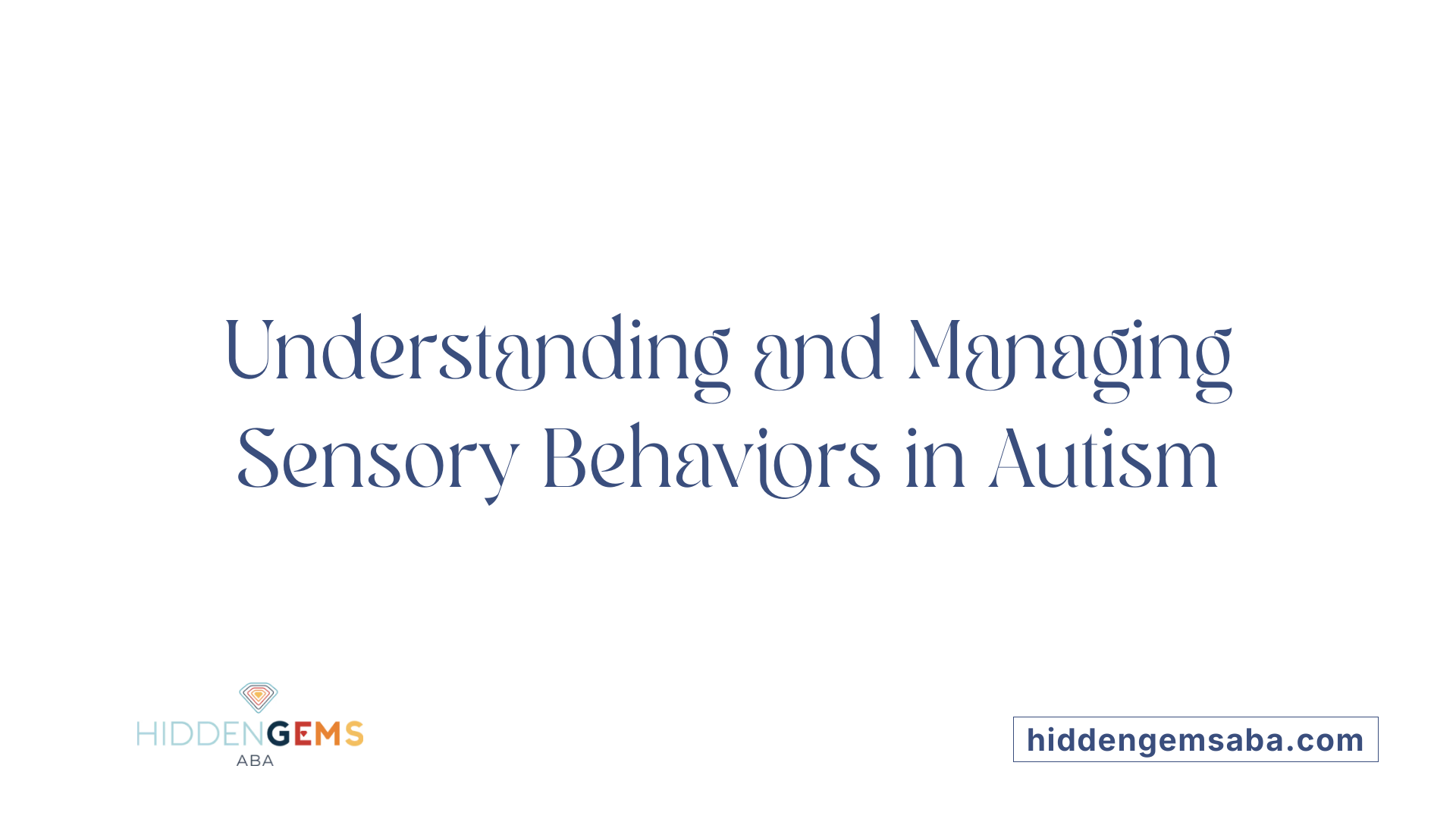Understanding the Intersection of ABA and Sensory Integration Therapy
For children on the autism spectrum, addressing both behavioral and sensory processing challenges is crucial for fostering development, independence, and quality of life. Applied Behavior Analysis (ABA) therapy and Sensory Integration Therapy (SIT) are two distinct yet often complementary approaches. This article explores their principles, applications, and the benefits of integrating these therapies to meet the diverse needs of individuals with autism.
Foundations of ABA Therapy and Sensory Integration Therapy

What is ABA therapy?
Applied Behavior Analysis (ABA) is a widely recognized and evidence-based treatment rooted in behavioral science. It focuses on enhancing social, communication, and adaptive skills by systematically reinforcing desired behaviors and decreasing unwanted ones. ABA employs techniques such as positive reinforcement, task analysis, and discrete trial training to promote meaningful behavior change.
Principles of sensory integration
Sensory integration is the brain’s natural process of organizing and interpreting sensory stimuli from touch, movement, and body position. It involves the tactile, vestibular, and proprioceptive systems, which are interconnected and vital for survival. When these systems function properly, individuals can respond adaptively to their environment. However, dysfunction in these areas can lead to sensory sensitivities, behaviors like withdrawal or seeking movement, and challenges in motor coordination.
How both therapies address developmental needs
Both ABA and sensory integration therapies aim to improve overall functioning by addressing specific developmental challenges. ABA can be adapted to include sensory strategies, creating a combined approach known as 'sensory integration ABA,' which uses reinforcement and behavioral techniques alongside sensory activities.
Sensory integration therapy (SIT) uses activities such as swinging, tactile play, and deep-pressure techniques to help children process sensory information more effectively. Research indicates that when implemented with fidelity, SIT can improve adaptive responses and sensory regulation, though current evidence highlights a need for more rigorous studies.
Together, these therapies not only target behavioral and sensory challenges but also support children in engaging more confidently with their environment, enhancing skills like communication, motor coordination, and emotional regulation.
Core Principles and Techniques of ABA in Sensory Challenges

Do ABA therapy incorporate sensory integration strategies?
Yes, ABA therapy often includes sensory integration strategies to better address sensory processing issues. These strategies involve sensory breaks, tailored activities, and environmental modifications such as quiet spaces or sensory-friendly tools. The goal is to help children tolerate a variety of sensory stimuli, thereby improving their sensory regulation and reducing distress.
How does ABA address sensory processing challenges?
ABA tackles sensory challenges by employing structured activities like task analysis and discrete trial training. Gradual exposure to sensory stimuli, combined with positive reinforcement, helps children build tolerance. Additionally, behavioral strategies such as deep-pressure therapy, sensory diets, and coping mechanisms like deep breathing or visual cues are used to decrease sensory overload and maladaptive behaviors.
Can ABA therapy allow stimming behaviors?
While some stimming behaviors can be disruptive, ABA generally does not aim to eliminate them entirely. Instead, it promotes managing stimming when it interferes with learning or safety. Supportive approaches focus on helping children self-regulate and use functional stimming for comfort, integrating acceptance of these behaviors as part of their individual coping strategies.
| Technique | Description | How It Helps |
|---|---|---|
| Positive Reinforcement | Rewarding desired behaviors | Encourages adaptive responses |
| Differential Reinforcement | Reinforcing specific behaviors while reducing others | Shapes appropriate behaviors |
| Task Analysis | Breaking down tasks into steps | Ensures successful learning |
| Discrete Trial Training | Structured, repetitive practice | Builds skill mastery |
| Sensory Breaks | Short breaks for sensory regulation | Prevents overload |
| Environmental Modifications | Adjustments to surroundings | Creates sensory-friendly spaces |
| Gradual Desensitization | Slowly increasing exposure | Increases tolerance |
How do ABA and sensory integration work together?
Many therapy programs combine ABA with sensory integration techniques, often called 'sensory integration ABA.' This approach merges behavioral principles with sensory activities such as swinging, tactile play, and proprioceptive exercises. By addressing both behavioral and sensory processing issues simultaneously, children may experience more balanced development both in their behavior and sensory regulation.
Final notes
Incorporating sensory strategies into ABA therapy requires ongoing assessment and collaboration with caregivers and therapists. Tailoring activities to individual sensory preferences and sensitivities enhances engagement and learning. As research continues, combining these methods offers promising avenues for supporting children on the spectrum in managing sensory challenges effectively.
Sensory Integration Therapy: Evidence and Practice

What scientific evidence supports SIT?
Research indicates that Sensory Integration Therapy (SIT) can be effective, particularly when delivered through the Ayres Sensory Integration® (ASI) model. Pioneering studies, such as those by Pfeiffer et al. (2011) and Schaaf et al. (2014), recognize ASI as a credible, evidence-supported approach for children with autism. These studies documented improvements in children’s ability to process sensory information, resulting in better social engagement, motor skills, and adaptive behaviors.
Recent trials also show promising results, including increased participation in daily activities and enhanced goal attainment. However, despite these findings, the overall scientific evidence remains limited and somewhat inconclusive, largely due to methodological challenges like small sample sizes and variability in intervention fidelity.
Most experts agree that high-quality, large-scale research is needed to firmly establish SIT’s effectiveness and to determine its long-term benefits and cost-effectiveness.
What are the three primary sensory systems involved in sensory integration?
The core systems involved in sensory integration are critical for understanding how individuals process their environment. These include:
- Tactile system: Involves touch and textures, which can be hypersensitive (overreactive) or hyposensitive (underreactive), affecting behaviors such as withdrawal or sensory seeking.
- Vestibular system: Regulates balance and movement, where dysfunction can cause fear of movement (hypersensitivity) or a desire for intense stimulation (hyposensitivity).
- Proprioceptive system: Provides awareness of body position, and issues here can lead to clumsiness, motor planning difficulties, and challenges with daily tasks.
Therapies aim to help individuals better interpret and respond to sensory inputs, improving overall functioning and participation.
Sensory Behaviors in Autism and Their Management

What is an example of a sensory behavior in autism?
Children with autism often display specific sensory behaviors as a way to self-regulate or meet sensory needs. Examples include spinning, rocking, repetitive touching of objects, banging surfaces, or fixating on certain lights. These behaviors are ways to respond to overwhelming or under-stimulating sensory environments.
How does sensory dysfunction manifest in behaviors?
Sensory processing issues can significantly influence behavior. Hypersensitivity may cause children to react intensely to loud noises or bright lights, leading to withdrawal or irritability. Hyposensitivity might lead to seeking excessive sensory input, such as constantly touching objects or moving excessively. Both scenarios can result in behaviors that challenge caregivers, but they are rooted in the child's attempts to process sensory information effectively.
Can sensory behaviors be supported and managed?
Yes, supported management involves understanding each child's unique sensory preferences and sensitivities. ABA (Applied Behavior Analysis) learns to identify specific triggers and develop strategies like sensory breaks, sensory-friendly materials, and environmental modifications. These techniques, combined with sensory integration activities such as tactile, proprioceptive, and vestibular exercises, help children improve their regulation.
ABA therapy often incorporates sensory strategies that gradually expose children to various stimuli at tolerable levels. This approach helps build resilience and reduce maladaptive responses. Additionally, active collaboration with caregivers ensures these strategies are consistently applied both at home and school, fostering better behavioral outcomes and emotional well-being.
For more information on managing sensory behaviors in autism, research suggests combining ABA with sensory integration therapy, which uses play-based, sensory-motor activities to enhance sensory processing and self-regulation skills.
| Sensory Behavior | Manifestation | Management Strategies | Tools and Techniques |
|---|---|---|---|
| Hypersensitivity | Withdrawal, irritability | Environmental modifications; sensory breaks | Weighted blankets, noise-canceling headphones |
| Hyposensitivity | Sensory seeking, excessive movement | Gradual exposure; sensory foods | Deep-pressure activities, tactile toys |
| Sensory Seeking | Repetitive movements, touching | Structured sensory activities | Swinging, textured objects |
| Sensory Avoidance | Avoidance of stimuli | Create sensory-friendly environments | Dim lighting, quiet spaces |
Understanding sensory behaviors and employing targeted ABA strategies can greatly improve a child's ability to participate meaningfully in daily activities, enhancing their overall quality of life.
Role of ABA in Managing Sensory Challenges
How does ABA support sensory regulation?
Applied Behavior Analysis (ABA) offers targeted strategies to help children manage sensory sensitivities more effectively. ABA techniques such as reinforcement, task analysis, and sensory breaks are crucial in this process. Reinforcement encourages desirable behaviors, while task analysis breaks down complex sensory responses into manageable steps, making them easier to address.
Sensory breaks allow children to pause and regulate when overwhelmed, promoting emotional balance and reducing maladaptive behaviors. ABA therapists carefully identify each child's sensory triggers and teach coping mechanisms, enabling children to better tolerate sensory stimuli like loud noises or tactile inputs.
What are practical ABA strategies for sensory sensitivities?
Implementing ABA for sensory challenges involves several practical techniques. Scheduled sensory breaks are built into daily routines, providing time for children to decompress and self-regulate. Environmental modifications, such as dimmed lights, noise-canceling headphones, or textured materials, create a more sensory-friendly environment.
Positive reinforcement plays a vital role; rewarding children for tolerating or engaging with sensory inputs helps foster acceptance and reduce avoidance behaviors. Gradual exposure to stimuli, carefully monitored and supported, promotes increased tolerance over time.
These methods work together to help children develop resilience and adapt to sensory stimuli in their surroundings, improving their overall functioning and emotional well-being.
Is parent training essential in ABA?
Yes, parent and caregiver training is fundamental to the success of ABA interventions. Educating families about sensory strategies ensures consistency across home and school environments. When parents understand how to recognize sensory sensitivities and apply techniques like sensory breaks or reinforcement at home, children experience more stable progress.
Training sessions also empower caregivers to implement environmental modifications and respond effectively to sensory-related behaviors. This collaborative approach reinforces the child's learning and supports generalization of skills across different settings.
Active involvement of parents and caregivers enhances the efficacy of ABA therapy, making sustained improvements in sensory regulation and overall development more achievable.
Integrating ASD Support: Combining ABA and Sensory Strategies
What are the benefits of combining ABA and sensory integration?
Integrating Applied Behavior Analysis (ABA) with sensory strategies creates a comprehensive approach that addresses both behavioral and sensory challenges faced by children with autism. While ABA focuses on teaching desired behaviors and reducing problematic ones through reinforcement and systematic techniques, sensory integration aims to improve how individuals process sensory information such as touch, movement, and sound. When combined, these methods support better emotional regulation, social interactions, and daily functioning.
Research indicates that blended therapies can lead to more significant improvements in life skills, including communication, social skills, and adaptive behaviors. By addressing sensory sensitivities alongside behavioral issues, children often experience increased tolerance to sensory stimuli, reduced maladaptive behaviors, and enhanced engagement in learning and social activities.
How can families implement integrated strategies?
Families play a vital role in reinforcing these strategies at home and in everyday settings. Collaboration with therapists allows caregivers to learn how to recognize sensory triggers and apply appropriate interventions consistently. Using sensory-friendly materials—such as weighted blankets, textured toys, or calming environmental modifications—helps children manage sensitivities.
Routine-based sensory activities, like swinging, deep pressure, or playing with textured objects, can be incorporated into daily schedules. Active reinforcement, whether through verbal praise, tokens, or preferred activities, encourages children to utilize coping skills and participate in sensory activities willingly. Consistent implementation across home, school, and community environments promotes skill generalization and stability.
Are there specialized approaches that combine both?
Yes, emerging practices like sensory integration ABA—also known as sensory integration therapy combined with ABA—tailor both behavioral and sensory interventions to each child's unique profile. These approaches blend the principles of ABA with sensory strategies such as sensory diets, graded exposure to stimuli, and sensory breaks.
By customizing interventions, therapists aim to improve sensory processing, help children tolerate various sensations, and reinforce adaptive behaviors. This holistic support enhances overall well-being, promotes independence, and fosters better participation in daily life.
| Approach Type | Focus Area | Techniques & Tools | Intended Outcomes |
|---|---|---|---|
| ABA | Behavior modification | Reinforcement, task analysis, discrete trials | Reduced maladaptive behaviors, increased skill acquisition |
| Sensory Integration | Sensory processing | Sensory diets, tactile/proprioceptive activities, weighted items | Improved sensory tolerance, emotional regulation |
| Combined (Sensory Integration ABA) | Behavior & sensory processing | Integrated activities, sensory-friendly routines, gradual exposure | Enhanced social, emotional, and functional skills |
Supporting Families and Caregivers with Resources and Guidance
What educational resources are available for parents and caregivers about therapy approaches for sensory and behavioral needs?
Parents and caregivers seeking to understand therapy options for sensory and behavioral challenges can access numerous online resources from reputable organizations. These include research articles, comprehensive FAQs, and parent guides that detail different therapeutic strategies like ABA and Sensory Integration Therapy. Additionally, directories of qualified specialists help families find local or virtual services to support their child's needs. These resources enable caregivers to learn practical ways to incorporate sensory activities at home and better understand their child's behaviors.
Are there professional resources for understanding therapies?
Yes, ongoing education from professionals is essential for effective intervention. Webinars, training sessions, and direct consultations with qualified clinicians provide updated knowledge, strategies, and tips for implementing ABA and sensory-based therapies. These resources are designed to help caregivers and educators stay informed about the latest practices and research findings, making intervention efforts more targeted and successful.
How can caregivers create sensory-friendly environments?
Creating sensory-friendly spaces at home or school can significantly reduce overstimulation and promote comfort. Tools such as weighted blankets and calming materials help manage sensitivities. Designating a sensory corner equipped with textured toys, soft lighting, and noise-canceling headphones can provide children a safe space to self-regulate. Simple environmental modifications, like reducing clutter, using soothing colors, and controlling background noises, foster an environment conducive to focus, emotional regulation, and positive engagement.
| Resource Type | Description | Best For |
|---|---|---|
| Parent Guides | Step-by-step strategies for sensory and behavioral support | Newly diagnosed children, new caregivers |
| Webinars and Trainings | Interactive sessions with professionals | Educators, therapists, parents |
| Specialist Directories | Listings of trained ABA and sensory therapists | Finding local support |
| Sensory Tools and Materials | Products like weighted blankets and textured toys | Creating sensory-friendly spaces |
| Online Forums and Support Groups | Community support and shared experiences | Ongoing emotional and practical support |
Understanding and utilizing these resources empower families to actively support their child's developmental journey. Consistent learning and environmental adjustments can enhance therapy outcomes and foster a nurturing, accommodating setting for children with sensory and behavioral needs.
Summary and Future Directions in Autism Support
What is the current understanding of the efficacy of ABA and SIT?
Applied Behavior Analysis (ABA) is a well-established therapy with a substantial evidence base supporting its effectiveness in improving social, communication, and adaptive skills in children with autism. It systematically uses reinforcement, behavior analysis, and skill-building techniques to modify behaviors and promote learning.
Sensory Integration Therapy (SIT), particularly through techniques like Ayres Sensory Integration (ASI), shows promise for addressing sensory processing issues. While some studies indicate improvements in self-regulation and engagement, the overall scientific evidence remains limited and inconsistent. More rigorous, high-quality research is needed to confirm SIT’s effectiveness, especially for long-term outcomes.
What are the gaps in current research?
Current studies on SIT face several limitations, including small sample sizes, methodological constraints, and a lack of long-term follow-up. Many existing trials do not adhere fully to fidelity principles, making it difficult to generalize findings or determine true efficacy.
Additionally, research on combined ABA and sensory approaches is sparse, highlighting a gap in understanding how these therapies can be seamlessly integrated for best results.
How can treatment approaches evolve?
To meet the complex needs of children with autism, future therapies should focus on personalized, integrated interventions. Combining ABA’s structured behavioral strategies with sensory integration techniques can address both behavioral and sensory challenges more holistically.
Ongoing research, along with professional training and caregiver involvement, will be essential for refining these approaches. Emphasizing practice-based evidence, adapting interventions to individual sensory profiles, and ensuring fidelity in implementation will help maximize therapy benefits.
By advancing toward a more individualized and flexible treatment paradigm, clinicians and families can better support children’s development, emotional well-being, and overall functioning.
| Aspect | Current State | Future Directions | Details |
|---|---|---|---|
| Efficacy Evidence | Strong for ABA; emerging for SIT | More rigorous, long-term studies needed | Collaborations between researchers, clinicians, and families to validate approaches |
| Research Gaps | Small samples, variable fidelity | Larger, controlled studies; focus on combined therapies | Focus on real-world outcomes and functional gains |
| Treatment Evolution | Focused therapies | Integration of behavioral and sensory strategies | Personalization, caregiver involvement, ongoing training |
| Technology & Tools | Traditional techniques | Use of wearable sensors and digital tools | Enhancing assessment, tracking, and adaptability |
Overall, the future of autism support lies in blending proven behavioral methods with sensory strategies tailored to individual needs, supported by rigorous research and collaborative care.
Towards a Holistic Approach to Autism Support
Integrating ABA and Sensory Integration Therapy offers a promising pathway to address the complex behavioral and sensory needs of children with autism. Ongoing research, personalized strategies, and caregiver involvement are key to advancing effective, holistic interventions that support meaningful growth, independence, and well-being.
References
- All You Need to Know About ABA and Sensory Integration Therapy
- Introduction - Sensory integration therapy for children with autism ...
- Can ABA Help with Sensory Issues? Discover the Benefits
- Sensory Integration in Autism Spectrum Disorders
- Sensory Processing: A Key Aspect of ABA Therapy
- How Does ABA Therapy Help With Sensory Processing?
- How ABA Therapy Complements Sensory Integration Therapy
- Sensory-Based Therapies | Kennedy Krieger Institute
- Introduction - Sensory integration therapy for children with autism ...
- Ten simple sensory strategies for autistic children






